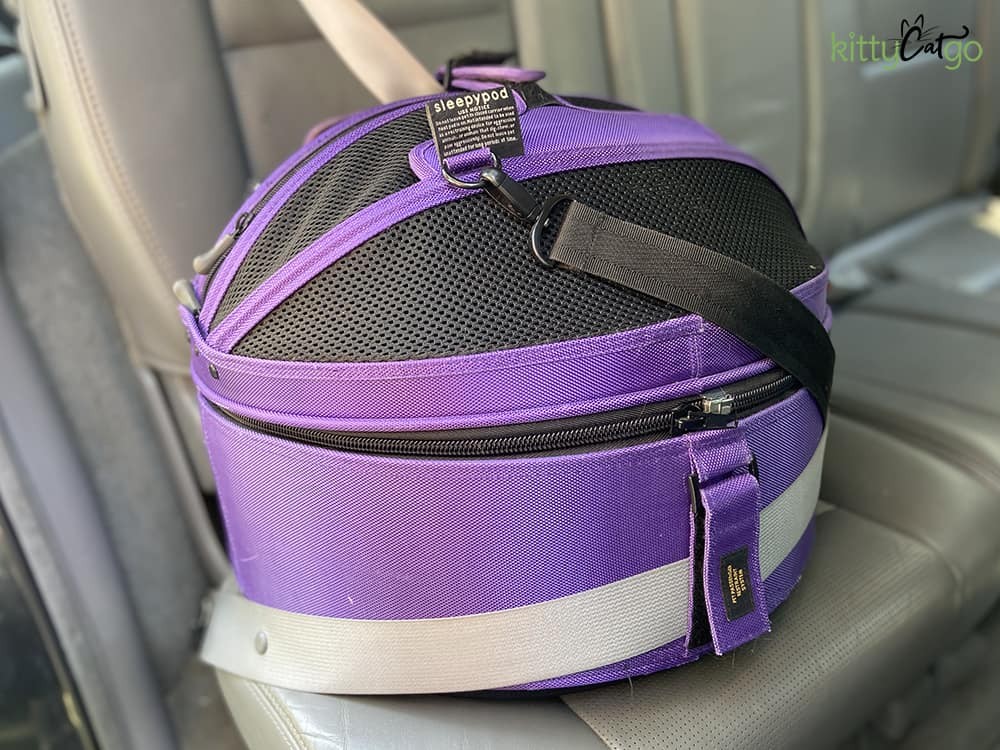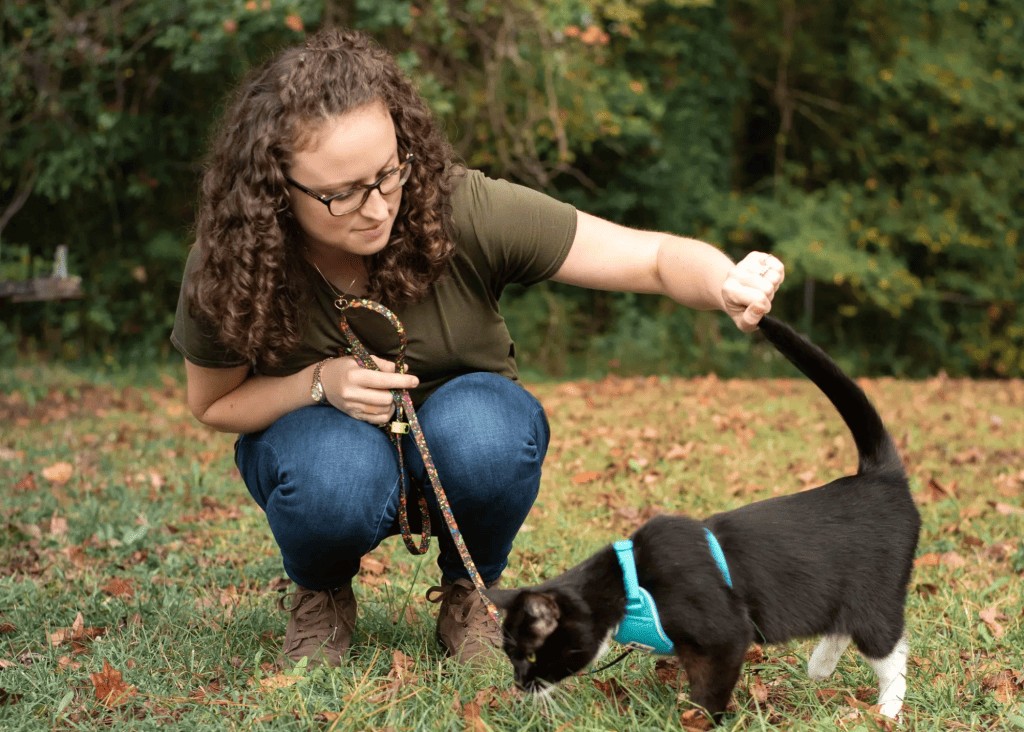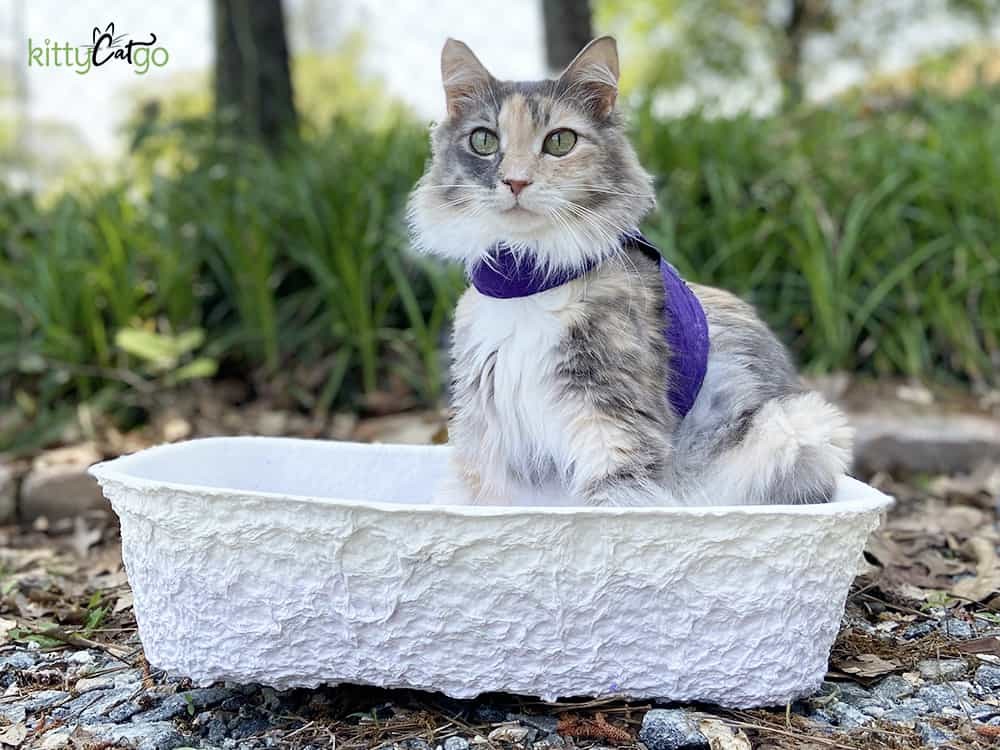Traveling with cats in car can be an enjoyable experience with the right preparation. SIXT.VN understands the challenges of pet travel in Vietnam and offers solutions for a smooth journey. Whether you’re planning a short trip or a cross-country adventure, these cat road trip tips will help you ensure a safe and comfortable ride for your feline friend. Consider using SIXT.VN for reliable transportation and pet-friendly travel advice.
1. Planning a Cat Road Trip: Essential Preparations
Planning a cat road trip requires careful consideration to ensure your cat’s safety and comfort. It’s not just about packing up and hitting the road; it involves several key steps to make the journey pleasant for both you and your feline companion. If your cat is already trained to wear a harness and leash, that’s a significant advantage. Here are the essential preparations you should make:
1.1 Selecting a Safe and Comfortable Cat Carrier
Choosing the right cat carrier is crucial for car travel. It’s the safest way for your cat to travel, regardless of their behavior. A carrier protects them from sudden stops, accidents, and unexpected events that could spook them.
One highly recommended option is the Sleepypod Mobile Pet Bed. This carrier doubles as a cat bed, allowing your cat to travel in a familiar and comfortable environment. It features a mesh-dome top that provides a clear view of the surroundings and has been crash-tested to ensure safety during car accidents. The Sleepypod can be secured with a seat belt, offering reliable protection.
 Sleepypod carrier for cat road trips
Sleepypod carrier for cat road trips
For longer trips requiring more space, the Pet Fit for Life carrier is a great alternative. While it lacks the crash-test rating of the Sleepypod, it offers ample room for your cat to stretch and move around. It can also be secured with a seat belt and includes a portable litter box, making it suitable for extended travel.
1.2 Practicing Short Drives with Your Cat
Acclimating your cat to car rides is essential, especially if they are not used to traveling. Start with short drives around the block to ease them into the experience. Gradually increase the distance over time. This practice helps them become comfortable with the motion and sounds of the car, reducing stress and anxiety. The goal is to make the carrier a safe and positive space for your cat.
Carrier Tip: Keep the carrier accessible at home so your cat can explore it freely. Feeding them inside the carrier can help create positive associations.
1.3 Ensuring Your Cat’s Identification is Up-to-Date
Updating your cat’s ID tags is a crucial safety measure. Although you don’t anticipate losing your cat, being prepared for unexpected situations is essential. Ensure the ID tags have current contact information. Microchipping your cat provides an additional layer of security, increasing the chances of reuniting with your pet if they get lost.
 Woman with cat outside on a harness and leash
Woman with cat outside on a harness and leash
1.4 Reserving Cat-Friendly Accommodations
Finding accommodations that welcome cats requires advance planning. Unlike traveling alone, you can’t simply stop at the first hotel you find. Cat-friendly options are not always easy to come by, so booking ahead is essential to secure a suitable place to stay.
When making reservations, always confirm that the accommodations are indeed cat-friendly. Some places may be listed as “pet-friendly” but only cater to dogs. Contact the hotel or rental directly to verify their cat policy and inquire about any additional fees for bringing your cat.
SIXT.VN can assist you in finding and booking cat-friendly accommodations, ensuring a hassle-free experience.
1.5 Planning for Litter Box Needs
For road trips longer than a few hours, planning for your cat’s litter box needs is necessary. There are several ways to manage this:
- Small Litter Box in Carrier: If the carrier is large enough, fit a small litter box inside.
- Pee Pads: Line the carrier with pee pads to absorb any accidents.
- Outdoor Breaks: If your cat is comfortable going outside on a harness and leash, plan stops at rest areas.
It’s important to have multiple plans in place, as your cat’s behavior can be unpredictable. Bring a litter box for pit stops and line the carrier with pee pads as a backup.
 Disposable litter box
Disposable litter box
1.6 Creating a Packing List for Your Cat
Traveling with cats requires packing a surprising amount of supplies. Essential items include food, water, a litter box, and cleaning supplies. It’s best to create a packing list to ensure you don’t forget anything important. Be sure to include the obvious essentials and anything else that might make your cat’s trip more comfortable and less stressful. You’ll want to pack extra of things like food and litter too. Best to be over-prepared than to run out of something on your trip.
2. Preparing for the Trip: Day-of Checklist
On the day of your trip, there are specific steps you can take to ensure a smooth and stress-free journey for both you and your cat. Here’s a day-of checklist:
2.1 Avoiding Feeding Before the Trip
To minimize the risk of nausea or vomiting, avoid feeding your cat in the hours leading up to the trip. They can wait until you reach your destination to eat.
2.2 Administering Medications as Advised by Your Veterinarian
If your cat is prone to motion sickness or anxiety, consult with your veterinarian about medication options. They may prescribe or recommend over-the-counter remedies to help keep your cat calm and comfortable.
Always follow your vet’s instructions and administer any necessary medications before you leave.
2.3 Exercising Your Cat Before Departure
Encouraging your cat to sleep during the road trip can make the journey much easier. Exercise your cat before you leave. A tired cat is more likely to rest quietly, reducing stress and potential issues during the drive.
2.4 Encouraging a Bathroom Break
Encourage your cat to use the litter box before getting into the car. While you can’t force them, placing them in the litter box may prompt them to go. Training your cat to use the litter box on command can also be helpful.
3. Hitting the Road: Essential Tips for Driving with Your Cat
Once you’re on the road, there are several considerations to keep in mind to ensure a safe and comfortable trip for your cat.
3.1 Keeping Necessities Handy
Pack a bag with your cat’s essential items and keep it within easy reach. This includes water, treats, medication, and pee pads. Having these items readily available allows you to address your cat’s needs quickly and efficiently.
3.2 Planning Pit Stops
Plan regular pit stops every few hours, especially on longer trips. These stops provide an opportunity for your cat to drink water, use the litter box, and stretch their legs. If your cat is leash-trained, a short walk can also help them relax.
3.3 Never Leaving Your Cat Unattended in the Car
Never leave your cat unattended in a car, particularly in extreme weather conditions. If you need to use the restroom and are traveling alone, consider these options:
- Two Sets of Keys: Use a second set of keys to lock the car with the air conditioning or heat running.
- Quick Stops: Run the A/C or heat on high before stopping, and make your restroom break as quick as possible.
 Woman with cat outside on a harness and leash
Woman with cat outside on a harness and leash
4. Understanding Your Cat’s Travel Personality: Is Your Cat an Adventurer?
Some cats are naturally more suited to travel than others. Assessing your cat’s personality can help you prepare for the road trip and make necessary adjustments. Consider factors such as their comfort level in new environments, tolerance for car rides, and overall temperament. SIXT.VN offers personalized consultations to help you understand your cat’s travel personality and plan accordingly.
5. Overcoming Challenges: Addressing Common Concerns
5.1 How to Manage Motion Sickness in Cats
Motion sickness can be a common issue when traveling with cats. Symptoms include nausea, vomiting, and excessive drooling. To manage motion sickness:
- Consult Your Vet: Discuss medication options with your veterinarian.
- Avoid Feeding Before Travel: Refrain from feeding your cat for several hours before the trip.
- Ensure Proper Ventilation: Keep the car well-ventilated.
- Take Breaks: Stop frequently to give your cat fresh air.
5.2 How to Keep Your Cat Calm During Car Rides
Anxiety and stress can make car rides unpleasant for cats. To help keep your cat calm:
- Use a Calming Carrier: Choose a carrier that provides comfort and security.
- Play Calming Music: Play soft, soothing music during the trip.
- Use Pheromone Sprays: Use pheromone sprays like Feliway in the carrier to reduce anxiety.
- Offer Familiar Items: Place familiar blankets or toys in the carrier.
5.3 What to Do if Your Cat Refuses to Use the Litter Box
Some cats may refuse to use the litter box during travel. To encourage them:
- Offer Familiar Litter: Use their regular litter in the travel litter box.
- Provide Privacy: Place the litter box in a quiet, private area.
- Take Frequent Breaks: Stop often to give them opportunities to use the litter box.
- Use Pee Pads: Line the carrier with pee pads in case of accidents.
6. Utilizing SIXT.VN for Seamless Cat Travel in Vietnam
SIXT.VN offers a range of services to make traveling with cats in Vietnam easier and more enjoyable. From airport transfers to pet-friendly accommodations, SIXT.VN provides comprehensive solutions for your travel needs.
6.1 Booking Pet-Friendly Airport Transfers
Arriving in Vietnam with a cat can be stressful. SIXT.VN offers pet-friendly airport transfer services to ensure a smooth transition. Our drivers are experienced in handling pets and will ensure your cat’s comfort and safety.
6.2 Finding Cat-Friendly Accommodations
Finding suitable accommodations that welcome cats can be challenging. SIXT.VN simplifies this process by providing a curated list of cat-friendly hotels and rentals in Vietnam. We verify pet policies and ensure your cat will be welcomed.
6.3 Planning Customized Pet-Friendly Itineraries
Exploring Vietnam with your cat can be an unforgettable experience. SIXT.VN offers customized pet-friendly itineraries that include visits to parks, pet cafes, and other attractions where your cat is welcome. Our team will help you plan a unique and enjoyable adventure.
7. Creating a Comfortable Car Environment for Your Cat
7.1 Temperature Control
Maintaining a comfortable temperature inside the car is vital for your cat’s well-being. Cats are sensitive to extreme temperatures, and overheating or becoming too cold can cause them distress.
- Air Conditioning: Use air conditioning to keep the car cool during hot weather. Ensure the air vents are directed away from the carrier to prevent direct drafts.
- Heating: In colder weather, use the car’s heating system to maintain a warm environment. Avoid overheating the car, as this can also be uncomfortable for your cat.
- Sun Protection: Use sunshades on the windows to prevent direct sunlight from overheating the carrier.
7.2 Ventilation
Proper ventilation is essential for ensuring your cat has fresh air and doesn’t feel suffocated in the carrier.
- Open Windows: If the weather permits, crack open the windows slightly to allow fresh air to circulate. Make sure the windows are not open wide enough for your cat to escape.
- Air Circulation: Use the car’s ventilation system to circulate air throughout the vehicle.
- Carrier Placement: Position the carrier in a way that allows for good airflow. Avoid placing it in direct sunlight or in a spot where air circulation is limited.
7.3 Minimizing Noise and Vibrations
Loud noises and vibrations can be stressful for cats, especially during car rides. Minimize these disturbances to create a more peaceful environment.
- Driving Smoothly: Drive smoothly and avoid sudden acceleration or braking.
- Reduce Noise: Keep the car radio at a low volume and avoid unnecessary honking.
- Secure Carrier: Secure the carrier with a seatbelt to minimize vibrations.
- Soft Padding: Place soft padding inside the carrier to absorb vibrations and provide cushioning.
8. Ensuring Legal Compliance and Safety
8.1 Understanding Local Pet Travel Laws
Before embarking on a road trip with your cat in Vietnam, it’s essential to understand and comply with local pet travel laws and regulations. These laws are designed to ensure the safety and well-being of both pets and the public.
- Vaccination Requirements: Ensure your cat is up-to-date on all required vaccinations. Carry proof of vaccination with you during the trip.
- Leash Laws: Be aware of leash laws in different areas. Some parks and public spaces may require cats to be leashed at all times.
- Pet-Friendly Areas: Research pet-friendly areas along your route, including rest stops, parks, and accommodations.
8.2 Pet Carrier Safety Standards
Choosing a pet carrier that meets safety standards is crucial for protecting your cat during car travel.
- Crash-Tested Carriers: Opt for carriers that have been crash-tested and meet safety regulations. These carriers are designed to withstand impact and protect your cat in the event of an accident.
- Secure Fastening: Ensure the carrier can be securely fastened with a seatbelt to prevent it from sliding or tipping over during the ride.
- Proper Ventilation: Choose a carrier with adequate ventilation to ensure your cat has fresh air.
- Durable Construction: Look for carriers made from durable materials that can withstand the rigors of travel.
8.3 Emergency Preparedness
Being prepared for emergencies is essential when traveling with your cat.
- First Aid Kit: Carry a pet-specific first aid kit with essential supplies, such as bandages, antiseptic wipes, and medications.
- Emergency Contacts: Keep a list of emergency contacts, including your veterinarian and local animal hospitals.
- Identification: Ensure your cat has proper identification, including ID tags and a microchip.
- Pet Insurance: Consider purchasing pet insurance to help cover the costs of unexpected veterinary care.
9. Fun Activities to Enjoy with Your Cat During Road Trips
9.1 Visiting Pet-Friendly Parks
Many parks and recreational areas welcome pets, providing a great opportunity to exercise and enjoy nature with your cat.
- Research Parks: Before visiting a park, research its pet policy to ensure cats are allowed.
- Leash Required: Keep your cat on a leash at all times to prevent them from getting lost or injured.
- Clean Up: Always clean up after your cat to keep the park clean and safe for everyone.
9.2 Exploring Pet Cafes
Pet cafes are becoming increasingly popular, offering a unique experience for pet owners to socialize with their cats in a relaxed environment.
- Find Pet Cafes: Search for pet cafes along your route and plan a stop for a fun and relaxing break.
- Socialization: Allow your cat to socialize with other cats and people in a controlled environment.
- Treats and Toys: Bring along treats and toys to keep your cat entertained.
9.3 Sightseeing with Your Cat
Sightseeing with your cat can be a rewarding experience, allowing you to share memorable moments together.
- Choose Pet-Friendly Attractions: Select attractions that welcome pets, such as outdoor markets, gardens, and historical sites.
- Use a Stroller or Carrier: Use a pet stroller or carrier to transport your cat safely and comfortably.
- Take Breaks: Take frequent breaks to allow your cat to rest and rehydrate.
10. Conclusion: Making Cat Road Trips a Paw-sitive Experience
Traveling with cats in car requires careful planning and consideration, but with the right preparation, it can be a rewarding experience. By following these tips and utilizing the services offered by SIXT.VN, you can ensure a safe, comfortable, and enjoyable road trip with your feline companion. Contact SIXT.VN today to start planning your next pet-friendly adventure in Vietnam.
Address: 260 Cau Giay, Hanoi, Vietnam. Hotline/Whatsapp: +84 986 244 358. Website: SIXT.VN.
FAQ: Traveling with Cats in Cars
1. What is the best way to prepare my cat for a car trip?
Start with short drives, gradually increasing the distance. Make the carrier a positive space with familiar blankets and toys.
2. How do I choose the right cat carrier for car travel?
Look for a carrier that is sturdy, well-ventilated, and crash-tested. The Sleepypod Mobile Pet Bed is a great option for safety and comfort.
3. How often should I stop for breaks when traveling with my cat?
Plan to stop every 2-3 hours to allow your cat to drink water, use the litter box, and stretch their legs.
4. What should I pack for my cat’s road trip?
Pack food, water, litter box, pee pads, medication, treats, and familiar blankets or toys.
5. How can I keep my cat calm during a car ride?
Use pheromone sprays, play calming music, and ensure the car is at a comfortable temperature.
6. Is it safe to leave my cat unattended in the car?
Never leave your cat unattended in the car, especially in extreme weather conditions.
7. What should I do if my cat gets motion sickness?
Consult your veterinarian about medication options and avoid feeding your cat before the trip.
8. How can SIXT.VN help with cat travel in Vietnam?
SIXT.VN offers pet-friendly airport transfers, cat-friendly accommodations, and customized pet-friendly itineraries.
9. What are the legal requirements for traveling with cats in Vietnam?
Ensure your cat is up-to-date on vaccinations and be aware of local leash laws and pet-friendly areas.
10. What should I do in case of an emergency during the trip?
Carry a pet-specific first aid kit, keep a list of emergency contacts, and ensure your cat has proper identification.



